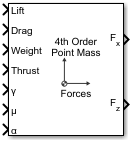4th Order Point Mass Forces (Longitudinal)
Calculate forces used by fourth-order point mass
Libraries:
Aerospace Blockset /
Equations of Motion /
Point Mass
Description
The 4th Order Point Mass Forces (Longitudinal) block calculates the applied forces for a single point mass or multiple point masses. For more information on the system for the applied forces, see Algorithms.
Limitations
The flat Earth reference frame is considered inertial, an approximation that allows the forces due to the Earth motion relative to the "fixed stars" to be neglected.
Ports
Input
Output
Algorithms

The applied forces [Fx Fz]T are in a system defined as follows: x-axis is in the direction of vehicle velocity relative to air, z-axis is upward, and y-axis completes the right-handed frame. They are functions of lift (L), drag (D), thrust (T), weight (W), flight path angle (γ), angle of attack (α), and bank angle (μ).
Extended Capabilities
Version History
Introduced before R2006a
